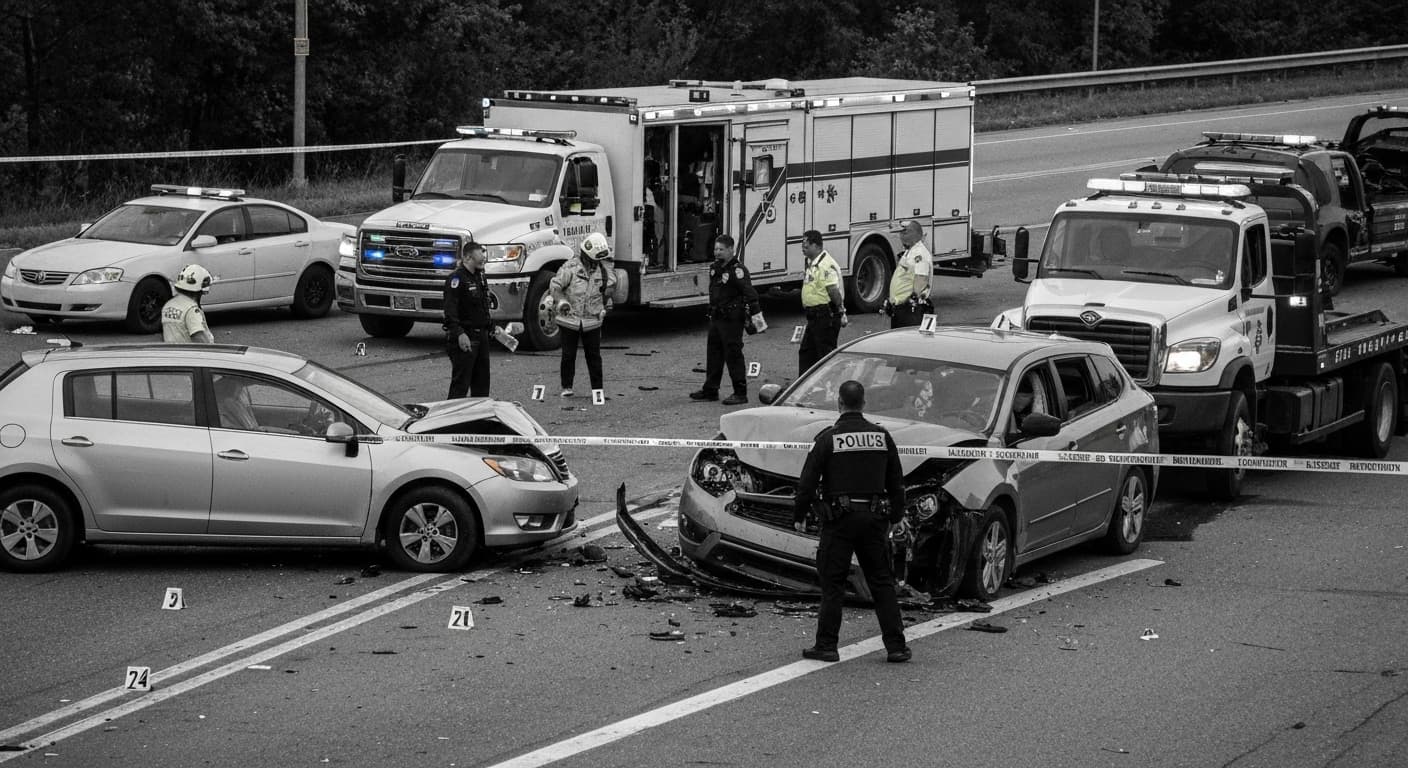
10 Most Common Driver Behaviors That Cause Accidents
Learn about 10 most common driver behaviors that cause accidents and how it affects your legal rights after a car accident. Get expert advice from experienced car accident attorneys.
# 10 Most Common Driver Behaviors That Cause Accidents
Car accidents can happen to anyone, but certain driver behaviors significantly increase crash risk and contribute to the majority of vehicle collisions. Understanding these common problematic behaviors can help drivers recognize and correct dangerous habits, potentially saving lives and reducing accident frequency. While human error causes approximately 90% of all car accidents, recognizing and addressing these behaviors can dramatically improve road safety. An experienced car accident attorney can provide guidance on accident prevention and legal protection strategies.
1. Distracted Driving
Distracted driving remains the leading cause of accidents, with drivers engaging in activities that divert attention from the road.
Common Distractions:
- Texting or using cell phone while driving
- Eating, drinking, or personal grooming
- Adjusting GPS navigation systems
- Interacting with passengers or pets
- Using social media or streaming services
- Daydreaming or losing focus on driving
Impact on Safety:
- Reaction times reduced by up to 50%
- Increased risk of rear-end collisions
- Difficulty maintaining lane position
- Failure to notice traffic signals and signs
- Impaired ability to anticipate hazards
2. Speeding and Aggressive Driving
Excessive speed and aggressive driving behaviors significantly increase accident risk and severity.
Speeding Behaviors:
- Exceeding posted speed limits consistently
- Driving too fast for road and weather conditions
- Tailgating and unsafe following distances
- Weaving through traffic dangerously
- Ignoring speed reduction in school zones
Aggressive Driving Patterns:
- Road rage incidents and confrontations
- Frequent horn honking and gestures
- Cutting off other vehicles intentionally
- Emergency lane usage for passing
- Intentionally blocking other drivers
3. Driving Under the Influence
Alcohol, drugs, or medication impairment severely compromises driving ability and judgment.
Alcohol Impairment Effects:
- Reduced reaction times and coordination
- Impaired judgment and decision-making
- Decreased visual acuity and depth perception
- Increased risk-taking behaviors
- Memory and attention problems
Drug and Medication Influence:
- Prescription medication drowsiness effects
- Marijuana impairment symptoms
- Stimulant effects causing reckless behavior
- Pain medication coordination impacts
- Over-the-counter medication interactions
4. Ignoring Traffic Signals and Signs
Failure to obey traffic control devices creates confusion and increases collision risk.
Traffic Signal Violations:
- Running red lights and stop signs
- Improper right-on-red turn execution
- Failure to yield at yield signs
- Ignoring flashing signal warnings
- Illegal U-turns at signal lights
Traffic Sign Non-Compliance:
- Speed limit sign disregard
- No-entry and one-way street violations
- Construction zone sign ignorance
- School zone speed limit failure
- Parking regulation violations
5. Improper Lane Changes and Merging
Unsafe lane changes and poor merging techniques cause many side-impact collisions.
Lane Change Errors:
- Failure to use turn signals properly
- Checking blind spots inadequately
- Cutting off other vehicles during changes
- Changing lanes too frequently or abruptly
- Lane drifting without intentions to change
Merging Problems:
- Highway entrance ramp merging failures
- Zip-merging improper execution
- Emergency lane merging without caution
- Construction zone merging difficulties
- Roundabout entry and exit errors
6. Following Too Closely (Tailgating)
Maintaining unsafe following distances prevents proper emergency reaction time.
Tailgating Risks:
- Insufficient stopping distance in emergencies
- Increased rear-end collision likelihood
- Pressure on lead driver causing aggressive reactions
- Reduced ability to see around larger vehicles
- Chain-reaction accident potential creation
Safe Following Guidelines:
- Three-second minimum following distance
- Increased spacing in adverse conditions
- Proper high-beam headlight usage
- Awareness of larger vehicle blind spots
- Anticipation of lead vehicle sudden stops
7. Failure to Yield Right of Way
Not yielding to other vehicles, pedestrians, or emergency vehicles creates dangerous situations.
Right-of-Way Violations:
- Intersection failure to yield
- Pedestrian crosswalk disregard
- Emergency vehicle right-of-way ignorance
- Roundabout yield sign non-compliance
- Driveway and side street entry failures
Yielding Best Practices:
- Complete stop before proceeding
- Eye contact confirmation when possible
- Emergency vehicle approach recognition
- Pedestrian and cyclist priority acknowledgment
- Intersection rule familiarity and compliance
8. Improper Turns and Maneuvers
Incorrect turning techniques and unsafe maneuvers contribute to many accidents.
Turning Errors:
- Wide turns causing lane encroachment
- Sudden lane changes during turns
- Failure to signal turn intentions
- Rolling stops at stop signs
- Improper left turn execution
Unsafe Maneuver Behaviors:
- Backing up on highways or busy roads
- Three-point turns in traffic
- Parallel parking in heavy traffic
- Sudden direction changes
- Improper passing techniques
9. Drowsy or Fatigued Driving
Driving while tired, drowsy, or fatigued impairs judgment and reaction times.
Fatigue Indicators:
- Yawning frequently while driving
- Difficulty keeping eyes open
- Wandering attention and daydreaming
- Slower reaction times noticeable
- Memory lapses about recent driving
Sleep-Related Risks:
- Microsleep episode occurrences
- Nighttime driving difficulty
- Long-distance driving fatigue
- Shift work sleep schedule disruptions
- Medication-induced drowsiness
10. Vehicle Maintenance Neglect
Poor vehicle maintenance can lead to mechanical failures and accidents.
Maintenance-Related Issues:
- Bald or worn tire failures
- Brake system malfunction
- Headlight and taillight failures
- Wiper blade degradation reducing visibility
- Steering and suspension problems
Preventive Maintenance Importance:
- Regular brake inspections and replacements
- Tire rotation and pressure checks
- Fluid level monitoring and changes
- Battery and electrical system checks
- Safety feature functionality verification
The Human Factor in Accidents
Cognitive and Behavioral Patterns
Decision-Making Errors:
- Risk assessment failure in driving situations
- Overconfidence in driving abilities
- Poor judgment in hazardous conditions
- Impulse-driven rather than rational choices
- Lack of awareness of personal limitations
Attention and Focus Issues:
- Multi-tasking while driving attempts
- Mental preoccupation with non-driving concerns
- Conversation engagement distractions
- Technology interaction diversions
- Emotional state driving performance impacts
Legal Consequences of Dangerous Behaviors
Traffic Violation Penalties
Civil and Criminal Penalties:
- License suspension or revocation periods
- Fine assessment and payment requirements
- Court appearance obligations
- Probation or community service assignments
- Defensive driving course mandates
Insurance Impact Consequences:
- Premium increase implementation
- Safe driver discount loss effects
- Claim denial possibility increases
- Future coverage availability limitations
- Rate increase duration considerations
Accident Prevention Strategies
Driver Education and Training
Defensive Driving Programs:
- Refresher course participation benefits
- Advanced driving technique learning
- Hazard recognition skill development
- Emergency situation response training
- Winter and adverse condition driving
Safe Driving Habits Development:
- Daily safety checklist implementation
- Passenger distraction management
- Technology usage limitation strategies
- Rest break scheduling for long drives
- Weather condition adaptation planning
Technological Safety Solutions
Vehicle Safety Technology Utilization
Advanced Driver Assistance Systems:
- Automatic emergency braking features
- Lane-keeping assistance technology
- Blind spot monitoring and warning systems
- Adaptive cruise control functionality
- Parking assistance and camera systems
Driving Monitoring Applications:
- Smartphone driving safety apps
- Dash camera incident recording systems
- GPS navigation with hazard alerts
- Fatigue detection and warning systems
- Speed monitoring and alert applications
Community and Policy Approaches
Public Safety Initiatives
Education and Awareness Campaigns:
- Safe driving awareness program development
- School and community education efforts
- Media campaign implementation for behavior change
- Peer-to-peer safety message dissemination
- Professional driver training program expansion
Law Enforcement Strategies:
- High-visibility enforcement program implementation
- Automated speed enforcement system utilization
- Drunk driving checkpoint establishment
- Seat belt compliance monitoring programs
- Motorcycle and bicycle safety initiatives
Personal Responsibility and Accountability
Self-Assessment and Awareness
Driving Ability Evaluation:
- Personal limitation recognition and acknowledgment
- Regular self-assessment practice implementation
- Professional driving evaluation consideration
- Family feedback solicitation and review
- Medical condition driving impact evaluation
Continuous Improvement Commitments:
- Safe driving pledge adherence
- Daily safety goal establishment
- Positive behavior reinforcement
- Peer influence recognition and management
- Community safety contribution participation
Conclusion: Behavior Change for Safety
The 10 most common driver behaviors that cause accidents represent preventable causes that drivers can identify and correct. From distracted driving to vehicle maintenance neglect, these behaviors contribute to the vast majority of preventable accidents on our roads. By recognizing these dangerous patterns and committing to safer driving habits, motorists can significantly reduce their accident risk and contribute to overall road safety improvements.
Remember that safe driving is a daily choice that affects not only personal safety but also the well-being of passengers, other road users, and communities. Professional driving training, regular vehicle maintenance, and personal accountability can help drivers avoid these common accident-causing behaviors and make our roads safer for everyone.


